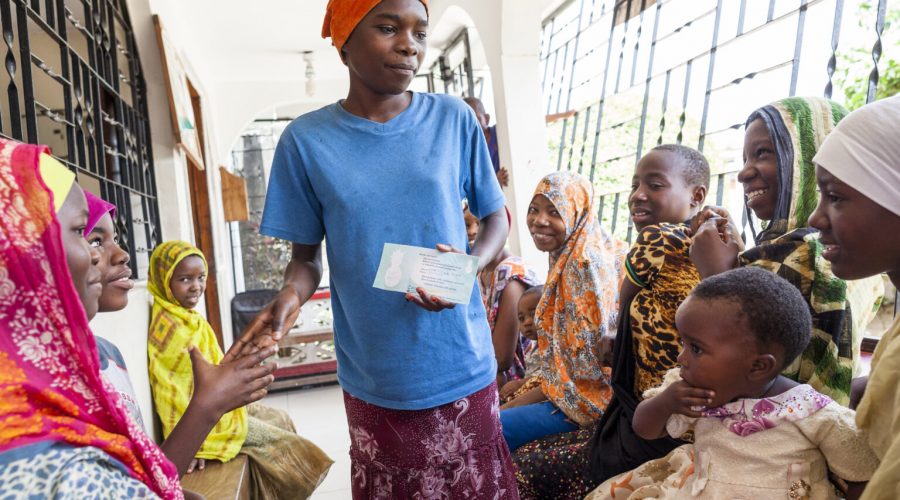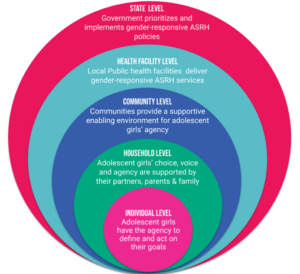By Matthew Wilson, A360 Project Director, PSI
A360 is on a learning journey, and we have committed to being radically transparent even if this is uncomfortable sometimes.
As we learn, our thinking evolves.
In recent months we have been giving a lot of thought to metrics. A360 is more than a service delivery program – we exist to support health systems to be more responsive to the unique needs of adolescent girls and to generate evidence and learning others can utilise.
But how do you measure the service delivery component of an adolescent sexual and reproductive health (ASRH) intervention?
Broadly speaking, sexual and reproductive health (SRH) interventions serve first-time users (never used), lapsed users (ever used) and continuing users (currently using, including method continuers and method switchers)[1]. However, the sector’s pursuit of additional user commitments[2] has all too often been reduced to the pursuit of first-time users when it comes to programming. Although during the first phase of the program A360 focused on reporting both first-time users and lapsed users[3], we have also felt the impetus to focus on first-time users.
Here’s what we are learning though: the value of an ASRH intervention goes well beyond first-time users.
1. Adolescent girls have unique patterns of need and use
Focusing on first-time users implies behaviour change pathways and user journeys are linear and unidirectional; that the best investment we can make is supporting women who have never used a modern contraceptive method to adopt one. We are learning it is not this simple, especially for adolescents.
Adolescents’ sexual activity – especially that of unmarried adolescents – is often unplanned, infrequent and fleeting. This is exacerbated by the prevalence of non-consensual sex[4]. Consequently, their need for and use of contraception may be far more intermittent than other age groups of women of reproductive age. They may choose to start and stop using contraception on a regular basis, discontinuing whenever relationships end[5]. Likewise, they may choose on-demand methods such as emergency contraception (EC) and condoms.
So what?
- We need to be responsive to adolescent girls’ unique patterns of need and use and support them to achieve the contraceptive user journeys they want. This may mean supporting adolescent girls to start, stop and resume contraceptive use on a regular basis.
- We need to be careful not to assume discontinuation is inherently problematic; the reality is more complex for adolescents.
- We need to work harder to expand access to and acceptability of on-demand methods such as emergency contraception (EC). Currently, EC represents a fraction of our method mix but it may be uniquely suited to adolescents who have infrequent and sometimes non-consensual sex.
2. We risk attributing too much value to prior use; prior use is heterogenous
Focusing on first-time users attributes a value to prior use which is unjustified given current adolescent contraceptive norms.
A first-time user is someone who adopts a modern contraceptive method for the first time in their life[6]. Any prior use of a modern method would disqualify someone from being categorised as a first-time user. A modern method that they self-administer (e.g. condom, EC, OCP), or one that requires an invasive medical procedure (e.g. LARC)[7]. A modern method used once (e.g. condom, EC), or one that provides protection for a several months / years without any further action (e.g. injectable, LARC). A modern method purchased from a pharmacy without counselling, or a modern method received after one-to-one counselling with a trained provider.
The expansive definition sets a low bar for prior use. This is problematic if we have a singular focus on first-time users because it assigns too much value to prior use. This is not a value judgement about which method or outlet a girl adopted a method, but a question of quality.
The evidence suggests lapsed and continuing users are likely to be / have been users of short-term self-administered methods, purchased from pharmacies and drug shops without quality counselling or a full method choice (directly or through the offer of referral)[8]. Furthermore, they are more likely than other age groups to have experienced contraceptive use failure and/or discontinued.[9] Given this, we must question how many lapsed and continuing users exercised informed choice[10] when they adopted their first or previous modern contraceptive method?
So what?
- We need to recognise the limitations of the first-time user metric and give more consideration to quality and informed consent. We need to distinguish between a decision to adopt a method and an informed choice to do so. Providing informed choice to an adolescent girl – whether she is a first-time user, lapsed user or continuing user – means providing more than a modern contraceptive method. It means equipping her with knowledge, confronting myths and misconceptions, providing a choice of methods, and improving the prospects of method fit and continuation when in need.
- We need to gather method information index data from first-time users to better understand the quality of prior use.
3. We need to accord the same value to all users
When we focus on first-time users it inevitably means we under value the time and expertise required to support lapsed and continuing users and the impact this makes. Current adolescent contraceptive norms mean many lapsed and continuing users will have similar knowledge of and attitudes towards contraception as a first-time user. Their prior use may have been a negative experience and left them more fearful of and resistant to contraception than a first-time user[11]. Consequently, it would require a comparable amount of time and expertise to reposition contraception, expand method choice[12], and provide evidence-based, user-centred counselling[13] to a lapsed or continuing user as a first-time user. Likewise, the impact this generates will be significant. Note too, continuing users include method switchers.
So what?
- The magnitude of the ASRH challenge and the scarcity of resources to meet it inevitably means we search for a panacea. We need to concede that there is none. The challenge is unavoidably multifaceted and complex.
- ASRH programmes cannot afford to focus on first-time users. We need to place equal emphasis on first-time, lapsed and continuing users. Ultimately, generating additional users[14] is dependent on it.
4. First-time user data on adolescents is fallible
A further challenge associated with focusing on first-time users is that identifying them is dependent on adolescent girls accurately recalling and reporting prior use. We are learning that this is constrained by several factors:
- Adolescent girls are often deterred from reporting prior use due to the stigma attached to premarital sex, which is often perpetuated by providers. This can be compounded by the age of consent, which stands at 18 years old in each of countries A360 works in.
- Prior use may be interpreted differently by the girl and/or the provider. For instance, the client and/or provider may reach different conclusions about whether prior use includes the condom a girl’s partner used, or the emergency contraception a girl used after unprotected sex.
- A short interaction with a stranger is not very conducive to accurate disclosure of prior use, particularly if there is stigma or confusion to overcome.
- Finally, whether a girl reports prior use accurately has no bearing on whether she receives the service. Faced with the stigma attached to premarital sex and an age of consent of 18 years old, it is conceivable an adolescent girl would choose not to disclose prior use.
So what?
- It is challenging to distinguish between first-time users and lapsed users accurately and meaningfully. Reporting first-time users alongside lapsed users means a program captures girls who recall and report prior use accurately and those who do not.
- To interpret this data we need to invest in mixed methods research to better understand girls’ contraceptive journeys.
- We need to mitigate the risks associated with recall and self-reporting of prior use. Strategies include employing client exit interviews to explore prior use with greater sensitivity and rigour than in a counselling moment.
How are you approaching these challenges?
What have you learned?
[1] In practice, terminology and definitions vary between health management information systems (HMIS), donors and implementers and are often conflated and confused. https://www.ncbi.nlm.nih.gov/pmc/articles/PMC5478230/
[2] Additional users is an aggregate population level metric which is the product of first-time users, lapsed users and continuing users.
[3] We used the umbrella term ‘adopter’ for girls who had never used a modern method or was not using a modern method at the time of last sex. This was driven by the data that was available across the health systems in which A360 worked.
[4] https://www.youthpower.org/youthpower-issues/topics/non-consensual-sex
[5] Blanc et al., (2009) Patterns and Trends in Adolescents’ Contraceptive Use and Discontinuation in Developing Countries and Comparisons With Adult Women, https://www.jstor.org/stable/40233806?seq=1#metadata_info_tab_contents and Chandra-Mouli et al., (2017) A Never-Before Opportunity to Strengthen Investment and Action on Adolescent Contraception, and What We Must Do to Make Full Use of It, https://link.springer.com/content/pdf/10.1186/s12978-017-0347-9.pdf
[7] Though there are variations in the definition, it can also include the lactational amenorrhea method (LAM).
[8] Even in facility settings, the evidence suggests adolescents and youth are less likely to receive the same standard of counselling as other women. For example: https://journals.plos.org/plosone/article?id=10.1371/journal.pone.0256295 and https://journals.plos.org/plosone/article?id=10.1371/journal.pone.0228714
[9] https://assets.prb.org/pdf21/best-practices-for-sustaining-youth-contraceptive-policy-brief.pdf
[10] Individuals have the ability to access accurate, clear and readily understood information about a variety of contraceptive methods and their use. To exercise full, free and informed decision-making, individuals can choose among a full range of safe, effective and available contraceptive methods (barrier, short-acting, long-acting reversible, permanent and emergency contraception). https://familyplanning2020.org/sites/default/files/rights-based-fp/FP2020_Statement_of_Principles_FINAL.pdf
[11] Blanc et al., (2009)
[12] Choice is expanded by removing barriers such as access and cost, as well as expanding access to DMPA-SC.
[13] Counselling for Choice (C4) is an evidence-based approach to contraceptive counselling that helps clients make the best choice about which method is right for them. Developed as a solution to many of the root causes of unmet need for contraception, C4C aims to help address: gaps in free and informed choice, dissatisfaction with side effects and bleeding changes, and discontinuation among users who wish to prevent pregnancy. C4C is aimed at changing the way providers and clients participate in family planning counselling discussions to ensure that clients are always at the center and have the power to make the contraceptive choices that meet their needs.
[14] Additional users are the net number of current contraception users above the baseline and is the product of first-time users, lapsed users and continuing users.




